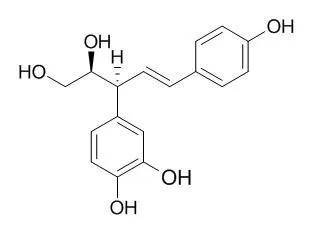| In vitro: |
| Z Naturforsch C. 2001 Mar-Apr;56(3-4):249-52. | | Antifeedants against Acusta despesta from the Japanese cedar, Cryptomeria japonica.[Pubmed: 11371016] |
METHODS AND RESULTS:
During our studies on the components in Japanese cedar, Cryptomeria japonica, we found that the crude methanol extract of C. japonica showed intense antifeeding activity against one snail species, Acusta despesta, which is well-known as a pest of many vegetables and crops. The active components in the extract were separated into the hexane and ethyl acetate soluble fractions. From the active ethyl acetate soluble fraction, two norlignans, sequirin-C and agatharesinol, were isolated and identified as the active compounds.
CONCLUSIONS:
Both compounds inhibited feeding behavior of A. despesta at 30 microg/cm2 and 40 microg/cm2 concentrations, respectively, when applied by an eggplant leaf or filter paper containing 20 microl of 5% sucrose solution. | | Phytochemistry. 2001 Nov;58(6):833-40. | | Preparation of antibody against agatharesinol, a norlignan, using a hapten-carrier conjugate.[Pubmed: 11684179] |
METHODS AND RESULTS:
In order to immunolabel heartwood extractives in Japanese cedar (Sugi, Cryptomeria japonica), we attempted to prepare antibodies against agatharesinol, a major norlignan of these heartwood extractives. Agatharesinol by itself is not antigenic due to its low-M(r), and thus was covalently bound to bovine serum albumin in order to synthesize an antigenic hapten-carrier conjugate (artificial antigen). The number of agatharesinol molecules per artificial antigen molecule was estimated as 27-28 by quantifying Lys in an acid hydrolysate of the artificial antigen by HPLC. Reaction between the artificial antigen and serum obtained from a rabbit immunized with the artificial antigen was competitively inhibited by agatharesinol, indicating the successful production of anti-agatharesinol antibodies. Inhibition by Sequirin C, another major norlignan in Sugi, was weaker than that by agatharesinol. Furthermore, an EtOAc soluble fraction, which contains mainly norlignans, inhibited the reaction more strongly than any of the other fractions of Sugi heartwood extractives.
CONCLUSIONS:
Thus, the antiserum we have produced reacts most strongly with agatharesinol and recognizes norlignans almost selectively among Sugi heartwood extractives. |
|






 Cell. 2018 Jan 11;172(1-2):249-261.e12. doi: 10.1016/j.cell.2017.12.019.IF=36.216(2019)
Cell. 2018 Jan 11;172(1-2):249-261.e12. doi: 10.1016/j.cell.2017.12.019.IF=36.216(2019) Cell Metab. 2020 Mar 3;31(3):534-548.e5. doi: 10.1016/j.cmet.2020.01.002.IF=22.415(2019)
Cell Metab. 2020 Mar 3;31(3):534-548.e5. doi: 10.1016/j.cmet.2020.01.002.IF=22.415(2019) Mol Cell. 2017 Nov 16;68(4):673-685.e6. doi: 10.1016/j.molcel.2017.10.022.IF=14.548(2019)
Mol Cell. 2017 Nov 16;68(4):673-685.e6. doi: 10.1016/j.molcel.2017.10.022.IF=14.548(2019)